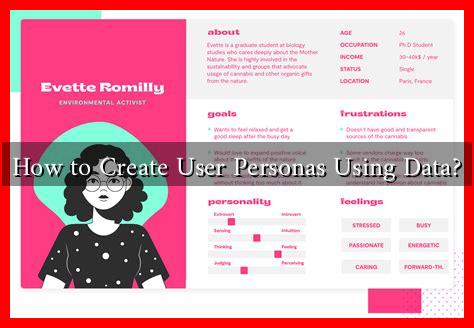-
Table of Contents
- How to Create User Personas Using Data
- Understanding User Personas
- Why Use Data to Create User Personas?
- Steps to Create User Personas Using Data
- 1. Collect Data
- 2. Identify Patterns and Trends
- 3. Create Persona Profiles
- 4. Validate Your Personas
- Case Study: How Spotify Uses User Personas
- Conclusion
How to Create User Personas Using Data
User personas are fictional characters that represent the different user types within a targeted demographic. They are essential tools in user-centered design, helping businesses understand their customers’ needs, behaviors, and goals. Creating user personas using data can significantly enhance product development, marketing strategies, and customer engagement. This article will guide you through the process of creating user personas backed by data, ensuring that your personas are not only realistic but also actionable.
Understanding User Personas
Before diving into the creation process, it’s crucial to understand what user personas are and why they matter. User personas are based on qualitative and quantitative data collected from real users. They help teams empathize with users, making it easier to design products and services that meet their needs.
Why Use Data to Create User Personas?
Data-driven user personas provide a more accurate representation of your target audience. Here are some reasons why using data is beneficial:
- Accuracy: Data helps eliminate assumptions and biases, leading to more reliable personas.
- Segmentation: Data allows for the identification of distinct user segments, ensuring that personas reflect diverse user needs.
- Actionable Insights: Data-driven personas can inform marketing strategies, product features, and user experience design.
Steps to Create User Personas Using Data
Creating user personas involves several steps, each requiring careful consideration of the data you collect. Here’s a structured approach:
1. Collect Data
The first step in creating user personas is gathering data from various sources. This can include:
- Surveys: Conduct surveys to gather quantitative data about user demographics, preferences, and behaviors.
- Interviews: Conduct qualitative interviews to gain deeper insights into user motivations and pain points.
- Analytics: Use web analytics tools (like Google Analytics) to track user behavior on your website or app.
- Social Media: Analyze social media interactions to understand user interests and sentiments.
2. Identify Patterns and Trends
Once you have collected data, the next step is to analyze it for patterns and trends. Look for:
- Common demographics (age, gender, location)
- Similar behaviors (purchase patterns, content consumption)
- Shared pain points and goals
Tools like Excel, Google Sheets, or more advanced analytics software can help you visualize this data effectively.
3. Create Persona Profiles
With the data analyzed, you can start creating persona profiles. Each profile should include:
- Name: Give your persona a name to humanize them.
- Demographics: Include age, gender, location, and other relevant demographic information.
- Goals: Outline what the persona aims to achieve.
- Challenges: Identify the pain points that the persona faces.
- Behavior Patterns: Describe how the persona interacts with your product or service.
4. Validate Your Personas
Validation is crucial to ensure that your personas accurately represent your users. You can validate your personas by:
- Conducting follow-up interviews with real users.
- Testing your personas against actual user behavior.
- Gathering feedback from team members who interact with users.
Case Study: How Spotify Uses User Personas
Spotify is a prime example of a company that effectively uses user personas. By analyzing user data, Spotify has created personas that reflect different listening habits and preferences. For instance, they have personas for casual listeners, music enthusiasts, and podcast lovers. This segmentation allows Spotify to tailor its marketing strategies and product features, enhancing user engagement and satisfaction.
Conclusion
Creating user personas using data is a powerful strategy that can lead to more effective product development and marketing. By following the steps outlined in this article—collecting data, identifying patterns, creating profiles, and validating them—you can develop user personas that truly reflect your audience. Remember, the more accurate your personas are, the better you can meet the needs of your users. For further reading on user personas, check out Nielsen Norman Group’s guide on user personas.

